Two-Sided Stable Matching Decision-Making Method Considering Matching Intention under a Hesitant Fuzzy Environment
Qi Yueand Zhibin Deng
1School of Management,Shanghai University of Engineering Science,Shanghai,201620,China
2School of Information Management,Jiangxi University of Finance and Economics,Nanchang,330013,China
ABSTRACT In this paper,a stable two-sided matching(TSM)method considering the matching intention of agents under a hesitant fuzzy environment is proposed.The method uses a hesitant fuzzy element (HFE) as its basis.First,the HFE preference matrix is transformed into the normalized HFE preference matrix.On this basis,the distance and the projection of the normalized HFEs on positive and negative ideal solutions are calculated.Then,the normalized HFEs are transformed into agent satisfactions.Considering the stable matching constraints,a multiobjective programming model with the objective of maximizing the satisfactions of two-sided agents is constructed.Based on the agent satisfaction matrix,the matching intention matrix of two-sided agents is built.According to the agent satisfaction matrix and matching intention matrix,the comprehensive satisfaction matrix is set up.Furthermore,the multiobjective programming model based on satisfactions is transformed into a multiobjective programming model based on comprehensive satisfactions.Using the G-S algorithm,the multiobjective programming model based on comprehensive satisfactions is solved,and then the best TSM scheme is obtained.Finally,a terminal distribution example is used to verify the feasibility and effectiveness of the proposed method.
KEYWORDS Two-sided matching;stable matching;hesitant fuzzy element;matching intention;programming model
1 Introduction
In the process of two-sided matching decision-making (TSMDM),two-sided agents yield the preference information according to their own needs and produce a reasonable matching scheme.The TSMDM problem widely exists in various fields,such as the freight source matching problem[1],blockchain-based task matching problem [2],cap-trade matching problem in carbon emissions[3],mentor-mentee matching problem[4],emergency rescue personnel and task matching problem[5]and so on.Gale et al.[6] first studied TSMDM problems with ordinal preferences.After the initial study,different types of preference information were used in the TSMDM problems,such as the linguistic term,ordinal number and interval number.For instance,Tong et al.[7]proposed a two-sided matching (TSM) model based on the preference information of linguistic terms.Pittel [8] proposed a TSM model under strict preference order.Hu et al.[9] presented a stable TSM model with oneside preference.Antler [10] studied TSMDM problems based on the endogenous preference ordinal number and proposed a new TSMDM method.Many scholars at home and abroad are devoting increasing attention to TSMDM because of the important roles of TSMDM theory and methodology in economic activities.
Currently,the preference information provided by people is often vague or uncertain due to the subjectivity and fuzziness of human thinking [11].Thus,preference information based on different forms of fuzzy sets has been noticed and studied by many scholars,including intuitionistic fuzzy sets,interval intuitionistic fuzzy sets,and triangular fuzzy numbers[12–14].These types of fuzzy sets mostly contain a membership and nonmembership element.However,in some decision-making scenarios,the decision-maker may not provide a single evaluation value,but rather multiple evaluation values.In addition,multiple decision-makers may give different evaluation information at the same time,and they may not convince each other due to conflicting opinions.For instance,in a venture investment matching problem,five experts in the field of venture capital may assign different evaluation values with respect to venture capital enterprises,such as 0.5,0.4,0.6,0.8 and 0.7.The traditional fuzzy sets mentioned above cannot effectively maintain the integrity of decision information.Compared with the traditional fuzzy sets mentioned above,the hesitant fuzzy set(HFS)proposed by Torra can maximize the retention of initial decision information due to the multiple membership degrees[15].In the case mentioned above,the preference information given by five experts can be described by the hesitant fuzzy element (HFE) {0.5,0.4,0.6,0.8,0.7}.Therefore,the TSMDM considering HFS preferences also has important research value.
Relevant studies on HFS have emerged in different fields.First,the basic theory regarding HFS has been generalized.For instance,Xu et al.[16]proposed various hesitant ordered weighted distance measures and corresponding hesitant ordered weighted similarity measures.Following Xu and Xia’s[17]research,a brand-new distance measure and similarity measure for higher order HFS were given in Farhadinia’s study.Liang et al.[18] developed a novel utility function for HFS.Liao et al.[19]proposed brand-new hesitant fuzzy weighted operators,including the hesitant power average operator,weighted hesitant power average operator,ordered weighted hesitant power average operator and hybrid weighted hesitant power average operator.Moreover,the application scope of HFS has expanded.For instance,a novel multiattribute group decision-making model based on the hesitant fuzzy superiority and inferiority ranking method and the interval-valued hesitant fuzzy superiority and inferiority ranking method was proposed by Ma et al.[20].Ullah[21]developed a new multiattribute group decision-making model based on the fuzzy picture Maclaurin symmetric mean operator.
In addition,according to the aforementioned literature,there have been many studies on the application of HFS in the TSMDM problem.For instance,Zhang et al.[22] established a stable TSM model considering multi-granular hesitant fuzzy linguistic term information and proposed an example for the matching of green building technology supply and demand to verify the effectiveness of this model.Li et al.[23] studied the complex product manufacturing problem and proposed a TSMDM method considering dual-hesitant fuzzy information.Yue et al.[24]developed a new HFS score function and constructed the corresponding TSMDM model.Zhang et al.[25]proposed a twosided matching method considering regret aversion psychological behavior and matching aspiration to solve TSM problems with intuitionistic fuzzy preference information.Xiang et al.[26]constructed a novel TSM model considering hesitancy and ambiguity and proposed a novel Pareto refining method,which can be applied in high-end equipment cloud manufacturing platform matching problems.
Although a considerable number of scholars have explored the TSMDM problem under HFS preferences from a variety of perspectives and have achieved some promising results,there are some deficiencies in the existing research.
First,in the TSMDM with HFS preference information,it is vital for decision-makers to find a reasonable tool to transform HFS preferences into exact values.In most of the existing studies,the TOPSIS method based on the distance measure or biprojection technology has been widely used in the TSMDM problem with HFS preference information.However,the above methods may still result in the loss of decision-making information in some cases.Hence,it would be meaningful to create an effective method to compute agent satisfaction.
Second,the matching intention coefficient,which reflects the matching intention of two-sided agents,plays an important role in the TSMDM problem.For some TSMDM problems,the matching intention coefficient may affect the final TSM result.However,it seems that the matching intention coefficient has been neglected in the aforementioned TSMDM model.Therefore,it would be practicable to develop a method to obtain the matching intention coefficient of two-sided agents in the TSMDM problem with HFS preference information.
Third,stability is of great significance for two-sided agents to achieve a reasonable and satisfactory matching result.However,this topic has not been fully discussed by many existing studies on the TSMDM problem in HFS preference environments.Thus,it is necessary to consider the stability of the TSMDM problem based on HFS preference information.
To overcome these deficiencies,this paper aims to develop a reasonable and effective method to cope with the TSMDM problem considering HFS preferences.Moreover,a TSMDM model with HFS preferences considering the matching intention coefficient is constructed.The key contributions of this work are as follows.First,we create an effective method to compute the agent satisfaction,which uses the distance measure and bi-projection technology.Second,we develop an effective method for calculating the matching intention coefficient of two-sided agents.Finally,a TSMDM model with HFS preference information considering stable matching constraints and matching intention is constructed.
The remaining structure of this paper is as follows: In Section 2,some relevant concepts of the TSM,HFS and HFE,and stable matching are presented.The stable TSM problem with HFS preference information considering matching intention is described in Section 3.Section 4 describes the TSMDM method with HFSs using TOPSIS technology.In Section 5,a TSM case is applied to verify the effectiveness and feasibility of the proposed method.Section 6 summarizes this paper.
2 Basic Concepts
In this section,we first introduce the basic concepts of the TSM,HFS and HFE.Then,the stable matching based on satisfaction is briefly described.
2.1 Two-Sided Matching
There are two agent sets in the TSM problem,namely,U={U1,U2,...,Um} andV={V1,V2,...,Vn}.Assume 2≤m≤nand supposei=1,2,...,m,j=1,2,...,n.
Definition 1.[22]Letθ:U∪V→U∪Vbe a mapping;if ∀Ui∈U,∀Vj∈V,θsatisfies three constraints:1)θ(Ui)∈V;2)θ(Vj)∈U∪{Vj};3)θ(Ui)=Vjifθ(Vj)=Ui;then,θ:U∪V→U∪Vis called a TSM.Here,(Ui,Vj) represents thatUiandVjmatch successfully in TSMθ;(Ui,Ui) and(Vj,Vj)represent thatUiandVjfail to match successfully in TSMθ.
2.2 Hesitant Fuzzy Set and Hesitant Fuzzy Element
Definition 2.[24]AssumeX={x1,x2,...,xn}is a fixed set;then,the HFSPinXcan be denoted asP={< x,p(x) >|x∈X},wherep(x)={pσ(1)(x),pσ(2)(x),...,pσ(lp(x))(x)}(x=x1,x2,...,xn) is a finite set of membership degrees within interval [0,1],andlp(x)represents the number of elements in HFEp(x).For convenience,note HFEp={pσ(1),pσ(2),...,pσ(lp)}.
Definition 3.[16]LetpAandpBbe two HFEs;then,the distance measures betweenpAandpBcan be denoted as:
wherepAσ(j)represents thejth element of HFEpA,j=1,2,...,lpA,andpBσ(j)represents thejth element of HFEpB,lpAandlpBare the length of HFEspAandpB,and supposelp=max{lpA,lpB}.
2.3 Stable Matching Based on Satisfaction
In the real TSMDM scenario,we assume thatfijis the satisfaction fromUitoVjandzijis the satisfaction fromVjtoUi.The definition of stable matching can be defined as follows.
Definition 4.[22]If neither of the following conditions occurs in a TSMθ:
(i) ∃Ui,Ul∈U,Vi,Vk∈V,s.t.θ(Ui)=Vk,θ(Ul)=Vj,wherefij >fikandzij >zlj;
(ii) ∃Ui,Ul∈U,Vi,Vk∈V,s.t.θ(Ui)=Vk,θ(Ui)=Ui,wherefij >fik;
thenθis called a stable TSM.
3 Stable Two-Sided Matching Problem Considering Matching Intention
In this section,we introduce the TSMDM problem based on HFE preference information considering the matching intention.
In the TSMDM problem,two-sided agents usually hesitate to assign their own preferences among multiple membership degrees.Therefore,to show the hesitancy and fuzziness of the evaluation information in TSMDM activities,we assume that two-sided agents provide hesitant fuzzy preference information.Furthermore,assumeU={U1,U2,...,Um} andV={V1,V2,...,Vn} are two sets of TSM agents.Supposeis the HFE matrix fromUtoV,wheresignifies the HFE information fromUtoV.Assumeis the HFE matrix fromVtoU,wheresignifies the HFE information fromVtoU.
The problem studied in this paper is as follows:how to construct a TSM model considering the matching intention and stable matching conditions according to the HFE preference matrices=given by two-sided agents.
4 Two-Sided Matching Decision-Making Based on Hesitant Fuzzy Elements
In this section,the TSMDM method based on HFE considering matching intention is presented.First,the HFE matrices are transformed into standardized HFE matrices.Then,the agent satisfaction matrices are calculated by using the TOPSIS and biprojection technology-based methods.Third,the TSM model considering the matching intention and stability is constructed by using the multiobject planning method.Finally,the optimal TSM scheme is obtained through the G-S algorithm.
4.1 Standardized Hesitant Fuzzy Element Matrix
According to Definition 2,we know thatlsignifies the number of elements in the HFE.However,the number of elements in the two HFEs is not the same in many decision scenarios.Therefore,the HFE is normalized based on the method proposed in the reference[23].Assuming two HFEsp1andp2,their lengths can be expressed asl1andl2.Under the condition of risk preference,the element with the maximum value is added to the HFE with the small valuel,so thatl=l1=l2;under the condition of risk aversion,the elements with minimum value are added to the HFE with the small valuelso thatl=l1=l2.At the same time,the elements in the HFE need to be sorted in descending order.
The normalized HFE matricesandcan be obtained by normalizing the HFE elements in matricesAccording to Definition 2,the lengthlej,∀i=1,2,...,mof HFEin matrixcan be represented as follows:
Therefore,the lengthlfi,∀j=1,2,...,nof HFEin matrixcan be represented as follows:
4.2 Construction of the Agent Satisfaction Matrix
The normalized HFE matrix is processed according to TOPSIS technology,and the following definitions are given with reference to the reference[24]and Definition 3.
Definition 5.[23]Given a normalized HFE matrixthe vectors of positive solution ˜e+and negative solutionare denoted as follows:
Definition 6.Let the normalized HFE,the positive ideal solution HFE and negative ideal solution HFE berespectively;then,andare called the standard Hamming distance of the positive ideal solution HFEand the normalized HFE,and the standard Hamming distance of the negative ideal solution HFEand the normalized HFE,whereandare computed by:
Definition 7.[23] Let the normalized HFE,the positive ideal solution HFE and negative ideal solution HFE be,,,respectively;then,andare called the projection of the vector formed by HFEand the negative ideal solutionon the positive ideal pointsand negative ideal points,and the projection of the vector formed by the positive ideal solutionand negative ideal solutionon positive ideal pointsand HFE,whereandare computed by:
According to Definition 6 and Definition 7 and the calculation theory of closeness in reference[24],the definitions of combined closeness are given below.
Definition 8.Letbe the combined closeness between the HFEand the positive and negative ideal solution,;then,can be computed as:
whereWDandWPrsignify the weights of the distance measure and projection,respectively.
In Eq.(8),the larger the combined closenessis,the closeris to the positive ideal solution,and the more distantis from the negative ideal solution:namely,the greater the satisfaction.Hence,the satisfaction matrixis calculated by Eq.(8).
Definition 9.[23]Given a normalized HFE matrixthe vectors of positive solutionand negative solutionare denoted as:
Definition 10.Let the normalized HFE,the positive ideal solution HFE and negative ideal solution HFE berespectively; then,andare called the standard Hamming distance of the positive ideal solution HFEand the normalized HFE,and the standard Hamming distance of the negative ideal solution HFEand the normalized HFE,whereandare computed by:
Definition 11.[23] Let the normalized HFE,the positive ideal solution HFE and negative ideal solution HFE berespectively;then,andare called the projection of the vector formed by the HFEand the negative ideal solutionon the positive ideal pointsand negative ideal points,and the projection of the vector formed by the positive ideal solutionand the negative ideal solutionon the positive ideal pointsand the HFE,whereandare computed by:
According to Definition 9,Definition 10,and the calculation theory of closeness in reference[24],the definitions of combined closeness are given below.
Definition 12.Letbe the combined closeness between the HFEand the positive and negative ideal solution,;then,can be computed as:
whereWDandWPrsignify the weights of the distance measure and projection.
In Eq.(15),the larger the combined closenessis,the closeris to the positive ideal solution,and the more distant from the negative ideal solution:namely,the greater the satisfaction.Then,the satisfaction matrixis constructed by Eq.(15).
4.3 Construction of a Two-Sided Matching Model Considering the Matching Intention and Stability
Based on the satisfaction matricesconstructed in the above section and the stable matching constraints in Definition 4,a TSM model with the objective of maximizing the agent satisfactions can be denoted as:
wherexijis defined as a variable from 0−1,≤1.i=1,2,...,mand≤1.j=1,2,...,nare defined as the one-to-one matching constraints,andis defined as the stable matching constraint.
Referring to the references[24,25],we know that the matching intention coefficient is associated with agent satisfaction and matching diversity.Thus,the optimal model for determining the matching intention coefficient considering matching satisfaction and matching diversity is constructed as follows:
To solve Model(M-2),the Lagrange function is introduced as follows:
Then,let
Hence,the optimal solution can be obtained on the basis of Eqs.(17)and(18),in which
Furthermore,the standardized matching intention coefficient can be computed by normalizing Eq.(19),in which
To concretely illustrate the calculation method of the matching intention coefficient given above,we take an example with three agents of each side.
Example 1.LetU={U1,U2,U3}andV={V1,V2,V3}be the sets of two-sided agents,where the satisfaction matrices of the two-sided agents are represented as:
then,the matching intention coefficient can be computed through Eq.(20)as follows:
According to Eq.(20),the matching intention coefficient matrixφ=[wij]m×nis constructed;then,the comprehensive satisfactiongijfromUitoVjand the comprehensive satisfactionhijfromVjtoUiare calculated as:
Therefore,Model(M-1)is transformed into Model(M-3)based on the comprehensive satisfactionsgijandhij:
4.4 Solution Process of the Two-Sided Matching Model Based on the G-S Algorithm
The framework of the solution process for TSM Model (M-3) based on the G-S algorithm is shown in Algorithm 1;then,the detailed procedures are presented as follows:
Step 1.For each agentUi (i=1,2,...,m),rank all agents of sideVaccording to the comprehensive satisfactions.For each agentV={V1,V2,...,Vn},rank all agents of sideUaccording to the comprehensive satisfactions,and then proceed to Step 2.
Step 2.For each agentUi (i=1,2,...,m),send a cooperation invitation to the agentVrat the top of sideU.If agentVris not matched and accepts the cooperation invitation,then match(Ui,Vr)is obtained.Otherwise,proceed to Step 3.
Step 3.For agentVrof sideV,choose the matching agent according to the comprehensive satisfaction ranking of sideU.If agentVrprefers agentUi+1rather thanUi,thenUistill remains free.If agentVrprefers agentUirather thanUi+1,then match(Ui,Vr)is obtained andUi+1is not matched withVr;then,proceed to Step 4.
Step 4.For other two-sided agents of sideVand sideU,rank all remaining agents of sideVand sideUaccording to the comprehensive satisfactions.Then,return to Step 2 until all agents of sideUare matched.
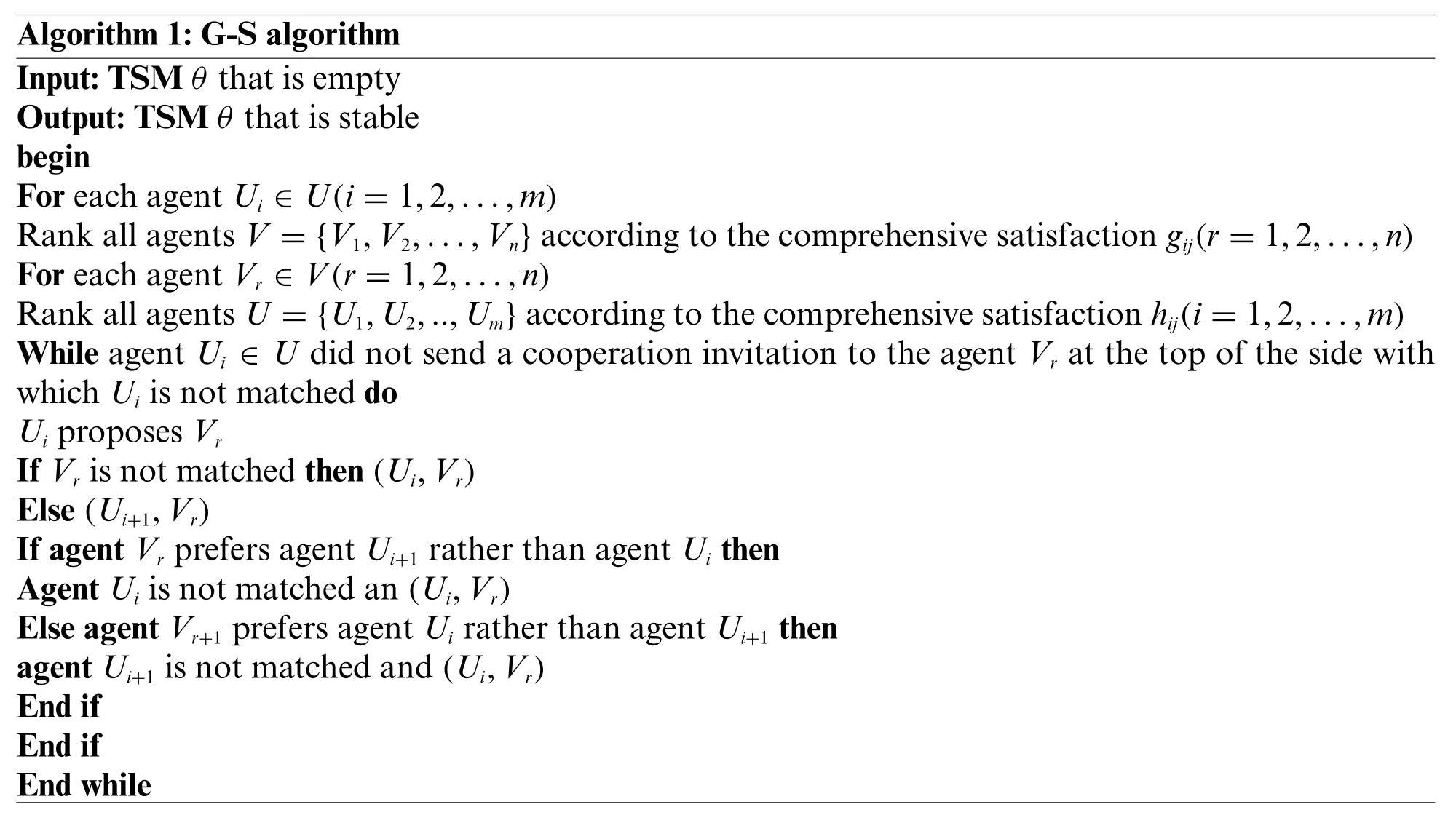
Algorithm 1:G-S algorithm Input:TSM θ that is empty Output:TSM θ that is stable begin For each agent Ui ∈U(i=1,2,...,m)Rank all agents V={V1,V2,...,Vn}according to the comprehensive satisfaction gij(r=1,2,...,n)For each agent Vr ∈V(r=1,2,...,n)Rank all agents U={U1,U2,..,Um}according to the comprehensive satisfaction hij(i=1,2,...,m)While agent Ui ∈U did not send a cooperation invitation to the agent Vr at the top of the side with which Ui is not matched do Ui proposes Vr If Vr is not matched then(Ui,Vr)Else(Ui+1,Vr)If agent Vr prefers agent Ui+1 rather than agent Ui then Agent Ui is not matched an(Ui,Vr)Else agent Vr+1 prefers agent Ui rather than agent Ui+1 then agent Ui+1 is not matched and(Ui,Vr)End if End if End while
4.5 Steps of Two-Sided Matching Decision-Making with Hesitation Fuzzy Set Preference
In summary,the steps of stable HFE TSMDM considering matching intention are given below:
Step 1.Transform HFE preference matricesinto normalized HFE preference matrices
Step 2.Transform normalized HFE matricesinto the agent satisfaction matricesthrough Eqs.(2)–(8)and Eqs.(9)–(15).
Step 3.Construct the TSM Model (M-1) based on the satisfaction matricesunder the one-to-one stable matching constraint.
Step 4.Calculate the matching intention coefficient matrixφ=[wij]m×nthrough Eq.(20)based on the satisfaction matrices
Step 5.Transform satisfactionsandinto the comprehensive satisfactionsgijandhijthrough Eqs.(21)and(22).
Step 6.Transform Model (M-1) into Model (M-3) based on the comprehensive satisfactionsgijandhij.
Step 7.Determine the stable alternative of TSM by solving Model(M-3)through Algorithm 1.
5 Case Study
In the business activities of enterprises,the terminal distribution problem is the last link in the enterprise supply chain.Currently,the quality of terminal distribution will affect the overall benefit of enterprises,so the terminal distribution plays an important role in the supply chain.At the same time,there are two decision-makers in a terminal distribution problem,namely,freight cars and terminal distribution centers.The decision-making process may be affected by many factors;therefore,we will consider a distribution problem between freight cars and terminal delivery points as an example to verify the validity and feasibility of the TSM model proposed in this paper.The framework of the proposed case is given in Fig.1.In addition,a comparison analysis is presented to clarify the advantage of the proposed model.
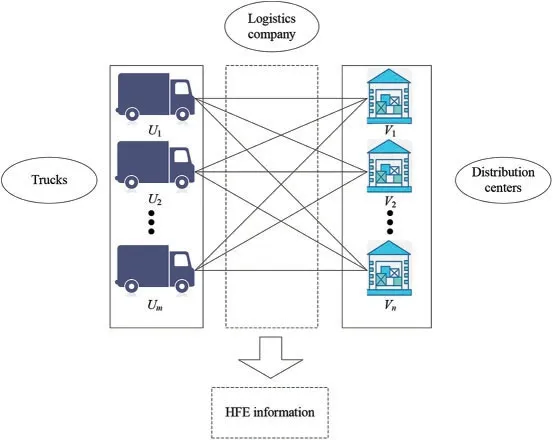
Figure 1:Framework of the terminal distribution problem
5.1 Steps of Two-Sided Matching Decision-Making with Hesitation Fuzzy Set Preference
GH is a third-party logistics enterprise specializing in LCL transportation.In a certain terminal distribution task,GH Company needs to arrange four trucks{U1,U2,...,U4}to transport different quantities of goods to five terminal distribution centers{V1,V2,...,V5}.The business department of the terminal distribution center will conduct a comprehensive evaluation of four trucks in terms of transportation speed,transportation volume,safety measures,movement cost,etc.,and then provide the hesitant fuzzy preference information for four trucks by means of questionnaires.The HFE evaluation matrixis given,as shown in Table 1.The freight department will conduct a comprehensive evaluation of terminal distribution stations based on fire protection measures,geographical location,informatization degree and other indicators,and then provide evaluation information in the form of an HFE for five terminal distribution stations through statistical analysis.The HFE matrixis given,as shown in Table 2.GH Company will optimize matching according to the HFE matricesgiven by two-sided agents and then provide an optimal matching scheme.
Table 1: HFE preference matrix

Table 1: HFE preference matrix
?
Table 2: HFE preference matrix

Table 2: HFE preference matrix
VanDistribution center V1V2V3V4V5 U1{0.5,0.6,0.8}{0.2,0.4,0.7}{0.1,0.3,0.8,0.9} {0.2,0.3,0.5}{0.4,0.5}U2{0.3,0.5,0.6}{0.1,0.3,0.6,0.8} {0.2,0.4,0.5}{0.3,0.7}{0.1,0.2,0.7}U3{0.1,0.3,0.6}{0.2,0.4,0.9}{0.4,0.6}{0.5,0.7,0.8}{0.3,0.5,0.6}U4{0.1,0.3,0.7}{0.2,0.4,0.5,0.6} {0.2,0.4,0.7}{0,2,0.6,0.9}{0.3,0.4,0.6}
5.2 Solution Process
The proposed method is adopted to solve the problem,and the solution steps are displayed as follows.
Step 1.Transform the HFE preference matricesgiven by the terminal distribution point and freight part into normalized HFE preference matricesas shown in Tables 3 and 4.
Table 3: Normalized HFE preference matrix

Table 3: Normalized HFE preference matrix
VanDistribution center V1V2V3V4V5 U1{0.2,0.3,0.4,0.4} {0.2,0.5,0.6,0.7} {0.1,0.2,0.9}{0.2,0.6,0.8}{0.1,0.6,0.7,0.7}U2{0.4,0.6,0.8,0.8} {0.2,0.3,0.5,0.9} {0.1,0.4,0.6}{0.1,0.4,0.7}{0.3,0.6,0.7,0.7}U3{0.1,0.4,0.5,0.9} {0.2,0.7,0.8,0.8} {0.3,0.5,0.9}{0.3,0.6,0.6}{0.3,0.7,0.8,0.8}U4{0.2,0.7,0.9,0.9} {0.3,0.5,0.6,0.6} {0.4,0.5,0.7}{0.2,0.4,0.5}{0.1,0.3,0.5,0.9}
Table 4: Normalized HFE preference matrix

Table 4: Normalized HFE preference matrix
VanDistribution center V1V2V3V4V5 U1{0.5,0.6,0.8,0.8} {0.2,0.4,0.7,0.7} {0.1,0.3,0.8,0.9} {0.2,0.3,0.5,0.5} {0.4,0.5,0.5,0.5}U2{0.3,0.5,0.6,0.6} {0.1,0.3,0.6,0.8} {0.2,0.4,0.5,0.5} {0.3,0.7,0.7,0.7} {0.1,0.2,0.7,0.7}U3{0.1,0.3,0.6}{0.2,0.4,0.9}{0.4,0.6,0.6}{0.5,0.7,0.8}{0.3,0.5,0.6}U4{0.1,0.3,0.7,0.7} {0.2,0.4,0.5,0.6} {0.2,0.4,0.7,0.7} {0,2,0.6,0.9,0.9} {0.3,0.4,0.6,0.6}
Step 2.Calculate the positive solutions for two-sided normalized HFE matrices through Eqs.(2)and (9): {0.4,0.7,0.9,0.9},{0.3,0.7,0.8,0.9},{0.4,0.5,0.9},{0.4,0.6,0.8},{0.3,0.7,0.8,0.9},{0.5,0.6,0.8,0.9},{0.3,0.7,0.7,0.8},{0.5,0.7,0.9},{0.3,0.6,0.9,0.9}.Calculate the negative solutions for two-sided normalized HFE matrices through Eqs.(3)and(10):{0.1,0.3,0.4,0.4},{0.2,0.3,0.5,0.6},{0.1,0.2,0.6},{0.1,0.4,0.5},{0.1,0.3,0.5,0.7},{0.1,0.3,0.5,0.5},{0.1,0.2,0.5,0.5},{0.1,0.3,0.6},{0.1,0.3,0.5,0.6}.
Construct the agent satisfaction matricesthrough the use of Eqs.(4)–(8)and Eqs.(11)–(15),as shown in Tables 5 and 6,whereWD=WPr=0.5.
Table 5: Agent satisfaction matrix

Table 5: Agent satisfaction matrix
VanDistribution center V1V2V3V4V5 U10.1770.3210.3110.6320.435 U20.6370.2560.2170.2450.551 U30.3870.7340.7530.5160.811 U40.8040.3100.6690.1150.147
Table 6: Agent satisfaction matrix

Table 6: Agent satisfaction matrix
VanDistribution center V1V2V3V4V5 U10.9080.3670.4560.0820.324 U20.4810.3600.2400.7800.269 U30.0000.3900.4840.7900.326 U40.2460.1420.3590.8780.280
Step 3.Then,Model(M-1)considering the stable matching constraints is constructed as:
Step 4.Based on the satisfaction matricesthe matching intention coefficient matrixφ=[wij]4×5is calculated through Eq.(16),as shown in Table 7;then,we transform satisfactionsandinto the comprehensive satisfactionsgijandhijthrough Eqs.(21)and(22),as shown in Tables 8 and 9.

Table 7: Matching intention coefficient matrix φ=[wij]4×5

Table 8: Comprehensive satisfaction gij

Table 9: Comprehensive satisfaction hij
Step 5.Transform Model (M-1) into Model (M-3) based on the comprehensive satisfactionsgijandhij.
Step 6.Determine a stable alternative of TSM by solving Model(M-3),as shown in Table 10.
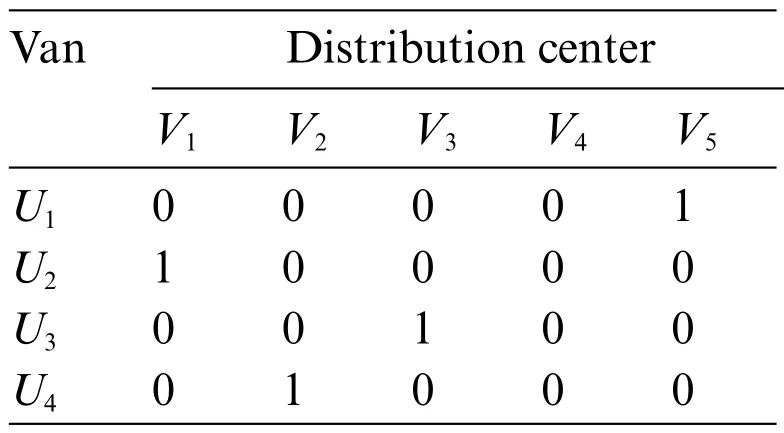
Table 10: The best TSM scheme
Therefore,the best TSM isθ=θ1∪θ2,whereθ1={(U1,V5),(U2,V1),(U3,V3),(U4,V2)},θ2={(V4,V4)},as shown in Fig.2.According to Fig.2,we can see that carU1and terminal distribution centerV5are matched,carU2and terminal distribution centerV1are matched,carU3and terminal distribution centerV3are matched,carU4and terminal distribution centerV2are matched,and terminal distribution centerV4is not matched.
Furthermore,we reconstruct Model(M-4)without the stable constraint:

Figure 2:The best TSM scheme between cars and terminal distribution centers
Then,the matching scheme can be obtained by solving TSM Model(M-4),as shown in Table 11.
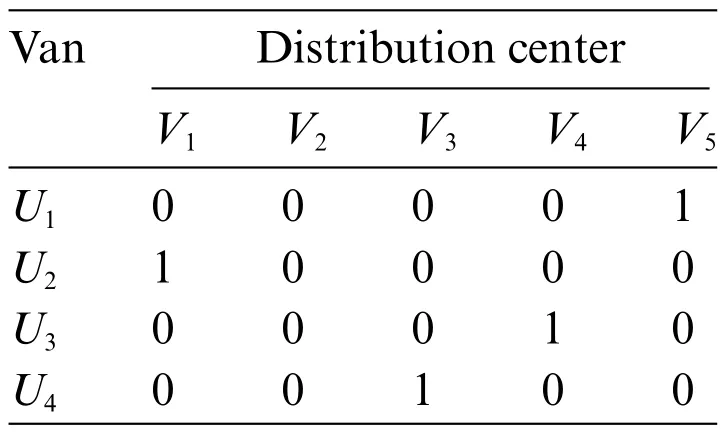
Table 11: The best TSM scheme without stability constraint
Hence,the best TSM scheme is determined from Table 11,i.e.,θ1={(U1,V5),(U2,V1),(U3,V4),(U4,V3)},θ2={(V2,V2)}.Furthermore,two TSM schemes are compared,as shown in Table 12.

Table 12: The comparison analysis for two TSM schemes
As seen from Table 12,in the best TSM schemes obtained through method I and method II,only(U1,V5) and(U2,V1) are the same,and other matching pairs are different.Furthermore,the model proposed in this paper better ensures the stability of the matching result and improves the satisfaction of two-sided agents as much as possible due to the stable matching constraints.
5.3 Comparative Analysis
First,there are several kinds of methods for dealing with fuzzy preference information,such as the TOPSIS method based on distance measures or biprojection technology.This paper adopted a brand-new method to deal with fuzzy preference information,which contains distance measures and biprojection technology.To further state the effectiveness of the method proposed in this paper,we compare the proposed method for handling hesitant fuzzy information with two methods given in references [16] and [23].Reference [23] only adopted the biprojection technology for transforming fuzzy preference information into exact values.Meanwhile,reference [16] adopted only the distance measure for transforming fuzzy preference information into exact values.The TSM results obtained by different methods are displayed in Table 13.From Table 13,it can be concluded that the TSM results obtained by the mentioned methods are different.Meanwhile,the methods proposed in references[23] and [16] may cause deviations in hesitant preference information in the process of conversion.Furthermore,the method proposed in this paper can effectively synthesize the advantages of the two methods proposed in the references[23]and[16].Therefore,the proposed method can guarantee the integrity of decision-making evaluation information.

Table 13: TSM results of different methods
Second,many of the existing TSMDM studies ignored the matching intention of two-sided agents.In this paper,the proposed TSMDM method considered the matching intention of matching agents,which can be applied to minimize the diversity of the TSM scheme.
Third,stability plays a significant role in the TSMDM process because the unstable matching pair may hinder the formation of matching results even if the satisfaction of two-sided agents is high.From the aforementioned research,we find that stability has not been fully considered in TSMDM problems in hesitant fuzzy preference environments.Hence,the one-to-one stable matching constraints are integrated into the TSMDM model developed in this paper,which can not only maximize the satisfaction of two-sided agents but also ensure a stable TSM scheme.
6 Conclusion
In this paper,a TSM decision-making model considering the matching intention and stability of two-sided agents under hesitant fuzzy preference is proposed.In this method,the normalized HFE is transformed into the agent satisfaction after normalizing the HFE preference information.A multiobjective programming model considering the agent satisfactions and the stable matching constraint is constructed.Based on the agent satisfaction matrices,the matching intention coefficient matrix is calculated,and then the comprehensive satisfaction matrices are calculated.Furthermore,the multiobjective programming model based on the satisfactions is transformed into the multiobjective programming model based on the comprehensive satisfactions.The best TSM scheme can be obtained by solving the developed model.
The main innovation of this paper can be denoted as follows: First,the TSM scheme obtained by the method proposed in this paper can reflect the matching intention of two-sided agents;second,the proposed method ensures the stability of the matching scheme.The TSM method proposed in this paper provides a new perspective for studying the TSM problem under the condition of HFS.
Further research work can be conducted as follows:
(1) In the proposed TSMDM method,we present a novel method including distance measures and biprojection technology for dealing with hesitant fuzzy preference information.However,due to the complex decision-making environment,the proposed distance measures may not fully reveal the comments of the decision-makers who have various preferences.Therefore,it could be practicable to develop a brand-new distance measure for HFS and the corresponding TOPSIS method.
(2) For some TSMDM problems,two-sided agents may provide multiple hesitant fuzzy preference information,such as probability hesitant fuzzy sets,interval hesitant fuzzy sets,and probability interval hesitant fuzzy sets.These would be interesting topics for developing a TSMDM model with multiple hesitant fuzzy preference information.
(3) It is meaningful to conduct research on the TSMDM problem considering bipolar hesitant fuzzy sets and T-spherical fuzzy sets[27]which can be used to solve decision-making problems in dynamic scenarios.
Funding Statement: This work was partly supported by the National Natural Science Foundation of China (Grant No.71861015),the Humanities and Social Science Foundation of the Ministry of Education of China (Grant No.18YJA630047),and the Distinguished Young Scholar Talent of Jiangxi Province(Grant No.20192BCBL23008).
Conflicts of Interest:The authors declare that they have no conflicts of interest to report regarding the present study.
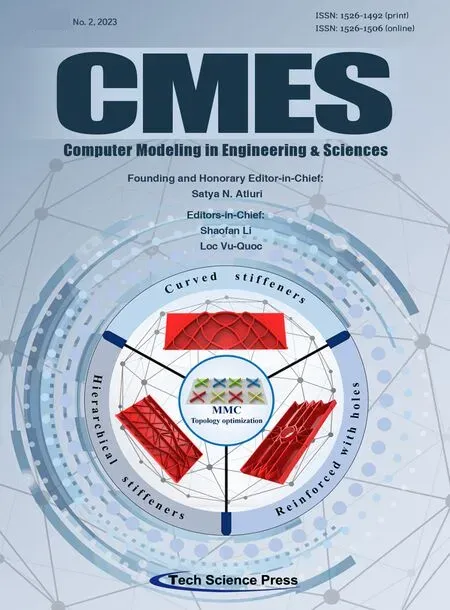 Computer Modeling In Engineering&Sciences2023年5期
Computer Modeling In Engineering&Sciences2023年5期
- Computer Modeling In Engineering&Sciences的其它文章
- Explicit Topology Optimization Design of Stiffened Plate Structures Based on the Moving Morphable Component(MMC)Method
- Towards a Unified Single Analysis Framework Embedded with Multiple Spatial and Time Discretized Methods for Linear Structural Dynamics
- Developments and Applications of Neutrosophic Theory in Civil Engineering Fields:A Review
- Surface Characteristics Measurement Using Computer Vision:A Review
- Recent Progress of Fabrication,Characterization,and Applications of Anodic Aluminum Oxide(AAO)Membrane:A Review
- Challenges and Limitations in Speech Recognition Technology:A Critical Review of Speech Signal Processing Algorithms,Tools and Systems
